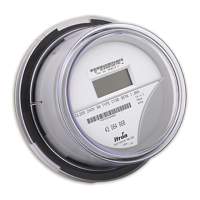Testing, Troubleshooting, and Maintenance
70 CENTRON® Meter Technical Reference Guide
TOU Rate Annunciators
The CENTRON meter is equipped with five Time-of-Use annunciators on the LCD.
Located on the right side of the display, the annunciator A, B, C, D, or t flashes when the
applicable rate is active and is enabled to display their respective values. (Available on the
C1ST and C1SL.)
Figure 36: TOU Rate Annunciator
Test Mode Annunciator
The CENTRON meter is equipped with a Test Mode LCD annunciator located in the right
portion of the display. This annunciator is enabled when Test Mode is activated. The word
TEST appears on the display and flashes at a steady rate when test mode is activated.
(Available on the C12.19 C1SD, C1ST, and C1SL.)
Testing with the Infrared Test LED
The CENTRON meter is equipped with an Infrared Test LED (Light Emitting Diode) which
is located on the top of the meter at the 12 o’clock position.
The pulse weight represented by the LED pulses is always 1.0 watt-hour per pulse. Since the
Kh value for the meter is 1.0, make sure the test board is programmed to accept this Kh
value.
# OF PULSES REQUIRED ON TEST BOARDS
1S & 2S CL200
120V 3S,
240V 3S,
240V 4S
12S & 25S, 2S CL
320
Full Load 10 7 15
Light Load 10 6 7
Power Factor 10 7 12
1 pulse = 1 Watt-hour as compared to 1 pulse = 7.2 Watt-hours in Electromechanical
meters.
To obtain test uncertainties of 0.01% (plus the uncertainties of the test equipment), use a
minimum of 30 pulses. With a constant load applied (real or phantom), the LED pulses are
compared to the output of a high accuracy watthour standard. This is accomplished using a
compatible optical pickup and a comparator.

